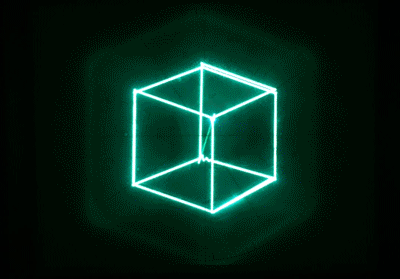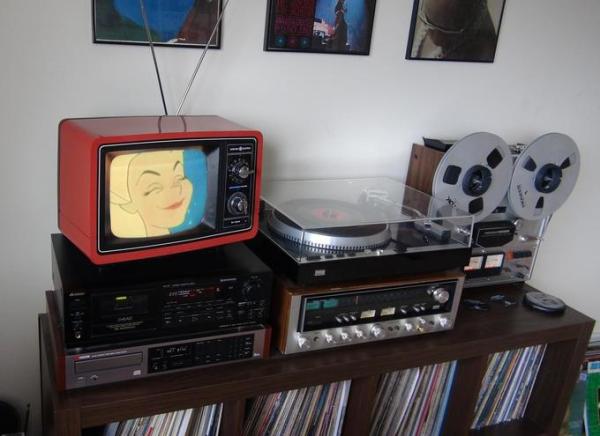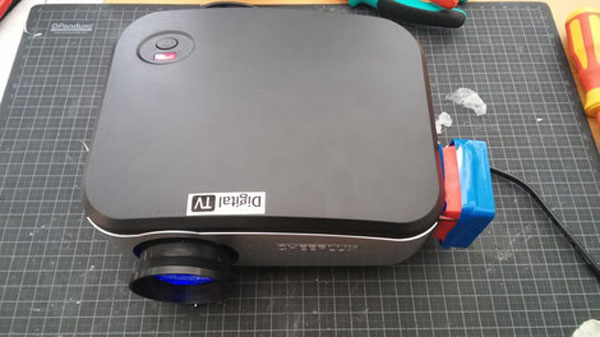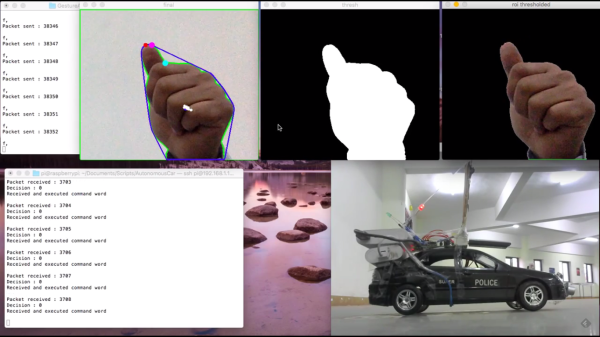From what we can understand, [ompuco] has built a 2D audio output on top of the Unity game engine, enabling him to output X and Y values from his stereo soundcard straight to an oscilloscope in XY mode. His code simply scans through all the vertexes in the scene and outputs the right voltages into the left and right audio streams. He’s using this to create some pretty incredible animations. Check out the video “additives” below for an example. (See if you can figure out what’s being “added”.)
Video Hacks631 Articles
8-bit Video Wall Made From 160 Gaming Keyboards
Well this is something we haven’t seen before. A video wall An 8-bit style video wall made from 160 RGB illuminated gaming keyboards.
On display at the PAX East gaming expo, the keys on 160 Logitech keyboards make up the “pixels” of a video wall showing a short film inspired from side-scroller video games. It’s the work of the production company iam8bit. Details on the system are scant, but we can learn a little from close observation of the video.
Continue reading “8-bit Video Wall Made From 160 Gaming Keyboards”
Chromecast Vintage TV Is Magic
When [Dr. Moddnstine] saw a 1978 General Electric TV in the trash, he just had to save it. As it turned out, it still worked! An idea hatched — what if he could turn it into a vintage Chromecast TV?
He opened up the TV and started poking around inside. We should note that old TV’s are pretty dangerous to open up if you’re not familiar with the components inside — high-voltages that could kill you linger on some capacitors. [Dr. Moddnstine] didn’t go into too much detail, so do a little extra research before you open up a TV.
Part of his goal for this project was to keep everything self-contained within the TV so all you would have to do is plug it into the wall in order to use it. Since the TV is so old, it doesn’t even have an analog RCA connections for a video input — just a VHF input. Because of this he needed to use three separate connection adapters to get the video signal to the TV.
Quieting A Cheap LCD Projector
There’s an old saying along the lines of “You pay peanuts, you get monkeys”. That’s true of technology, too, but a good hacker can sometimes teach an old monkey new tricks. [Heye] bought an LCD projector for $60 off AliExpress, and it turned out to be rather noisy: the air fan that sucked in air to cool the LED light source made a whooshing noise.
No surprise there, but rather than give up, he decided to see what he could do about the noise. So, he took the projector apart. After some excavation, he realized that the main source of noise was the input fan, which was small and partly covered. That’s a recipe for noise, so he cut out the plastic grille over it and mounted a larger, quieter fan on the outside. He also designed and 3D printed an external hood for this larger fan. The result, he says, is much quieter than the original, and still keeps the LED light source fairly cool. It’s a neat hack that shows how a few hours and a bit of ingenuity can sometimes make a cheap device better.
Projector hacks are a staple here. And our favorite? Swapping out the light source for a candle.
A Comparison Of Early Graphics Cards
We have to admit, we expected to be bored through [The 8-Bit Guy]’s presentation, only to stay riveted through his comparison of early graphic card technology.
Some presentations get a bit technical, which isn’t bad, but what is so interesting about this one is the clear explanation of what the market was like, and what it was like for the user during this time. For example, one bit we found really interesting was the mention of later games not supporting some of the neat color hacks for CGA because they couldn’t emulate it fully on the VGA cards they were developing on. Likewise, It was interesting to see why a standard like RGBI even existed in the first place with his comparison of text in composite, and much clearer text in RGBI.
We learned a lot, and some mysteries about the bizarre color choices in old games make a lot more sense now. Video after the break.
The Most Immersive Pinball Machine: Project Supernova
Over at [Truthlabs], a 30 year old pinball machine was diagnosed with a major flaw in its game design: It could only entertain one person at a time. [Dan] and his colleagues set out to change this, transforming the ol’ pinball legend “Firepower” into a spectacular, immersive gaming experience worthy of the 21st century.
A major limitation they wanted to overcome was screen size. A projector mounted to the ceiling should turn the entire wall behind the machine into a massive 15-foot playfield for anyone in the room to enjoy.
With so much space to fill, the team assembled a visual concept tailored to blend seamlessly with the original storyline of the arcade classic, studying the machine’s artwork and digging deep into the sci-fi archives. They then translated their ideas into 3D graphics utilizing Cinema4D and WebGL along with the usual designer’s toolbox. Lasers and explosions were added, ready to be triggered by game interactions on the machine.
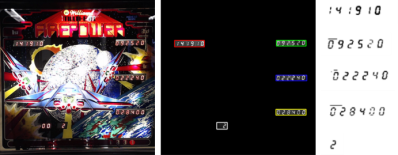
To hook the augmentation into the pinball machine’s own game progress, they elaborated an elegant solution, incorporating OpenCV and OCR, to read all five of the machine’s 7 segment displays from a single webcam. An Arduino inside the machine taps into the numerous mechanical switches and indicator lamps, keeping a Node.js server updated about pressed buttons, hits, the “Lange Change” and plunged balls.
The result is the impressive demonstration of both passion and skill you can see in the video below. We really like the custom shader effects. How could we ever play pinball without them?
Continue reading “The Most Immersive Pinball Machine: Project Supernova”
Hand Gestures Drive Car
There are a number of ways to control an automobile without using the pedals, and sometimes even without using the steering wheel. Most commonly these alternative control mechanisms are installed in vehicles whose owners are disabled in some way, but [Anurag] has taken this idea of alternative control one step further. He has built a car that can be driven by hand gestures alone.
On a remote controlled car, a Raspberry Pi 2 was installed that handles processing and communication. A wireless network is created on the Pi, and a laptop connects to the Pi over the network. The web camera on the laptop regularly captures frames at 15 fps to check for the driver’s hand gestures. The image is converted to gray scale, thresholded, contours are obtained, and the centroid and farthest points are obtained.
After some calculations are done, a movement decision is taken. The decision is passed to the Pi, which in turn, passed that to the internal chip of the car. All of the code is available on the project’s github page. [Anurag] hopes that this can be scaled up to full sized cars in the future. We’ve seen gesture-based remote controls before that rely on Sonar sensors, so it’s interesting to see one that relies strictly on image processing.

